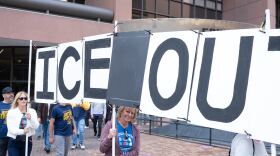The spectacular failure of the American solar company Solyndra has focused attention on the struggle of renewable energy to compete in a global marketplace. But in an industry reeling from recent turmoil, there may be a bright spot – in Arizona. The manufacturer First Solar makes those iconic photovoltaic panels more cheaply than anyone else.
Out here in the Phoenix suburb of Mesa, it’s hard to feel the gloom that’s been shadowing the solar industry.
“We’re standing at the location of First Solar’s second US manufacturing facility,” said Melanie Friedman, a spokeswoman for the company that is a titan in the solar industry. “We’re in the middle of construction now and expect to be finished in a little less than a year.”
Friedman is leading a tour of the skeleton of a building. When the factory is done, glossy black panels – one after another – will emerge from here. Many are destined to blanket the desert floor near Yuma, Arizona at a solar power facility.
“The whole reason we decided to build this factory in the U.S. Southwest is because of the demand in this area,” the spokeswoman said.
The power plant is called Agua Caliente. Up to 5 million solar panels are expected to power about 100,000 homes a year. The company is quick to say that when it comes on line around 2013, Agua Caliente will become the largest solar project of its kind in the world.
Ryne Raffaelle is an industry expert at the Rochester Institute of Technology. He said First Solar grew into this global giant for a reason: Cost and efficiency.
It doesn’t rely on silicon to make its product, unlike most of the world. That’s allowed First Solar to produce a panel for about $.75 cents a watt – when most Chinese competitors can only go as low as a $1.10 per watt.
First Solar’s been around since 1999. Last year, it did $2.6 billion dollars in sales.
The problem is the American solar industry is struggling to stand on its own.
First Solar got more than $50 million dollars in local incentives to build the Mesa factory. Company officials said up to $5 billion dollars in federal loan guarantees were critical to get the utility projects financed. Those are the same kind of guarantees the California solar company, Solyndra, received before it went bankrupt. Now, that financial backing is increasingly unpopular in Washington – a concern to some analysts.
Axiom Capital Management’s Gordon Johnson doesn’t believe American companies – even the biggest American company – can compete. He said massive government investment in Asia is tipping the scale and helping Chinese manufacturers, like GCL, creep closer to First Solar’s envied production costs.
“First Solar is in big trouble. Big trouble,” Johnson said. “(The Chinese) are going after First Solar’s pipeline. And they will win.”
Johnson and other analysts said there’s another problem: Demand and incentives in critical European markets has fallen, leaving a glut of supply. In the second quarter, sales at First Solar were off 9 percent compared to the same time last year. Its stock price has fallen by more than half from its 52-week high.
At First Solar headquarters outside of Phoenix, T.K. Kallenbach said the company will get through the uncertainty.
“You have to be an optimist in this business,” said Kallenbach, an executive with the company. “You’ve either got to pull your costs down faster or you’re going to have a loss maker.”
By 2014, he said First Solar will get those production cost from $.75 cents a watt down to about $.55 cents. Analysts said that will go a long way to compensate for China’s advance and to lessen the oversupply problem.
To Kallenbach, reaching that goal is imperative.
“You can’t have a billion people in India and China coming on line with the kind of energy thirst we’ve had in the US for the last 60 or 70 years,” Kallenbach said. “The world can’t sustain it. So you have to do it.”
What’s more, analysts said the lower costs go, the quicker First Solar can wean itself from the political uncertainty of government subsidies. And that’s exactly what the company said it wants – to shine on its own.






